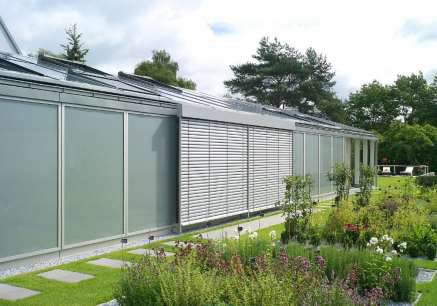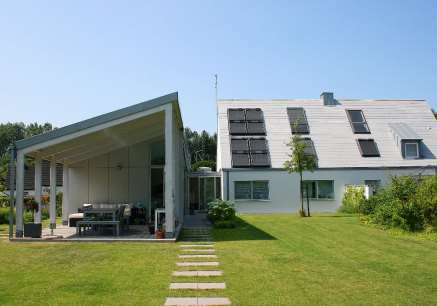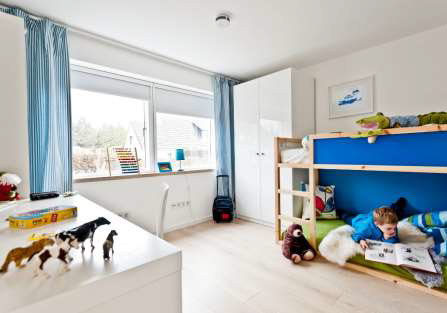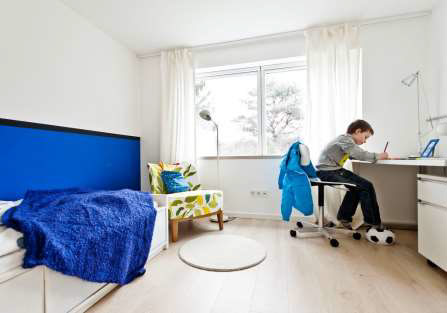LichtAktiv Haus, an old house with a new soul
LichtAktiv Haus is a 1950’s building which gained new life with a renovation following the Active House principles. It was awarded with an Active House label to showcase that old constructions can be the basis of modern and energy efficient buildings. When old walls meet innovation and technology to become a comfortable and environment friendly home.
LichtAktiv Haus was among the shortlisted projects participating to the Active House label contest. The jury, composed by international experts, included Rory Bergin, Arch MSc, Partner, Sustainable Futures, HTA Architects (England), Duzan Doepel, Partner, architect, DoepelStrijkers, (The Netherlands). Marco Imperadori, Professor, Politecnico di Milano (Italy) and Mónika Tornóczky, MSc. Architect, product manager of Alukönigstahl (Hungary) decided to award this projects because it shows clearly how the Active House principles of comfort for the occupants, attention to the environment and energy efficiency can be applied when renovating an old building.

Indeed, the project transformed a so-called ‘settler house’, designed in the 1950s and situated in the
Wilhelmsburg district of Hamburg, into a modern construction with a settler’s self-sufficient spirit. The transformation is made to a premium CO2 neutral level, however the project also identified other scales, like a basis and extended versions to be replicated in other “settler houses”.
The home’s box-like, closed structure was reorganized into a series of open, spacious rooms flooded with natural light. A new modular extension with beautiful views of the large garden created an open kitchen, living and dining area. New openings in the roof of the extension, referred to as a ‘daylight lamp’, expanded the interior and brought in plenty of light. And a five metres long, garden-facing glass façade expanded the environment horizontally, with the porch becoming a link between the old and the new.
‘We have lived here for 5 years now and we have realized is that we feel better in this house compared to the old one. We feel better with the large volume and space in the rooms. We feel that we do not need the same sleeping time as in the past, and finally we fell less ill here than in the old home’ the owners of the house told us.
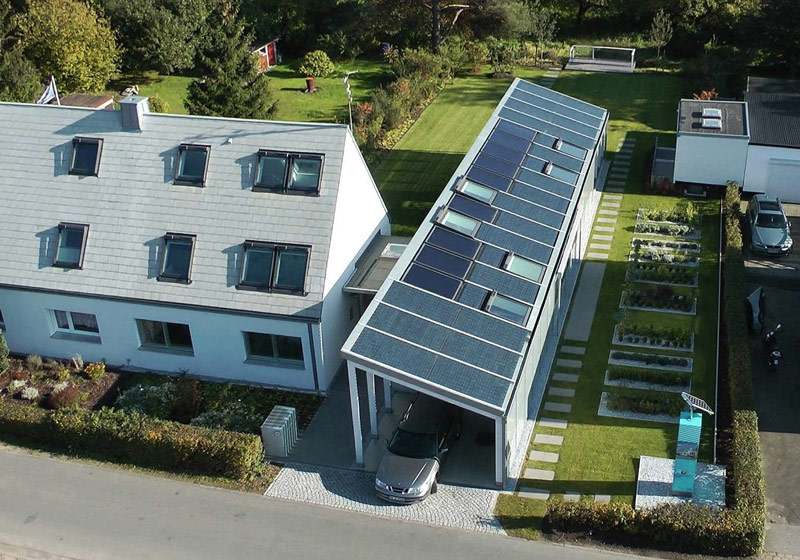
The energy-efficient design concept, which relies on solar energy, numerous façade and roof windows, and a natural ventilation system, turned a traditional home into a carbon-neutral one that pays tribute to the past while embracing the future.
‘We were surprised that we could produce our own energy and today we sell more electricity than we use for our building’ the owner said.
The architects explained that this was their first project where ‘simple low tech solutions turn an old house into an energy efficient building. We could not reach the newest standards in the old part, but combined with the new annex with kitchen and living room, we managed to turn the project into a design that will meet future energy demand for 2020, and even into a CO2 neutral building.
We used LCA evaluations to identify what to change in the existing building and where relevant we used the existing structure to save grey energy, from among others the heavy construction units like the slap, walls etc.’.
Architect: Katharina Fey (TU-Darmstadt ee) and Professor Manfred Hegger;
Work-planning architects: Ostermann Architekten; Küchen
Engineer: HL-Technik, Peter Andres Lichtplanung, TSB-Ingenieure
Developer: The VELUX group
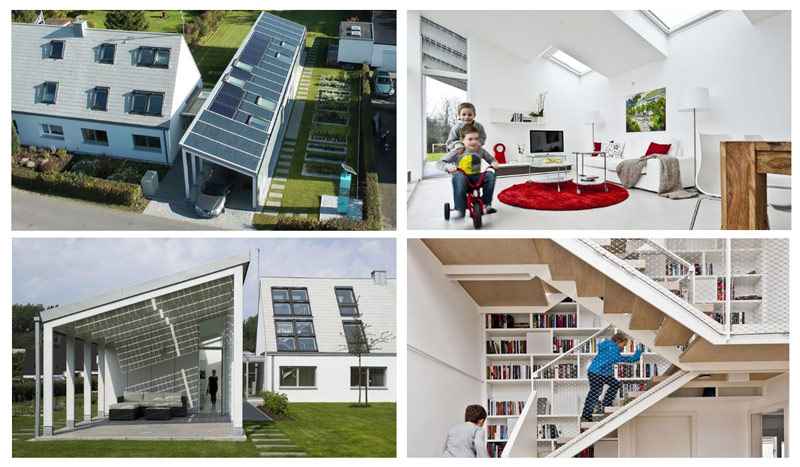
ENERGY:
Our future homes need to provide healthier, more comfortable living environments – without negatively impacting our climate. LichtAktiv Haus offers a high standard of living full of fresh air and daylight while covering its entire energy demand, including electricity, through renewable energy.
This is a particular challenge when renovating older homes as they often have much higher energy demands.
During the winter, passive solar heat gain through the roof windows reduces the need for heating, while shutters and blinds help prevent overheating in the summer. The windows combine optimum solar gain transmittance (g-value) and thermal transmittance (U-value), and they face the sun in order to reduce the use of artificial light.
An air-water-heat pump and 22.5 m² of solar collectors work together to supply the home with heating and hot water. This highly-efficient technology reduces greenhouse gas emissions by minimising the need for conventional energy. The home’s 75 m² of polycrystalline photovoltaic cells on the roof power the heat pump and also act as a source of environmentally friendly electricity.
The many windows in LichtAktiv Haus have shutters and blinds to ensure a comfortable indoor climate at all times. During the summer, south-facing shutters shield the house from the sun in the afternoon. And on the building’s western side, external awning blinds lower automatically in the afternoon. In the evening, the shutters and blinds are raised again to let in the fresh, cool air. In the colder months, the shutters stay up to allow passive solar heat to warm the home, and at dusk the shutters close to keep the heat inside.
INDOOR CLIMATE:
Sunlight not only influences our internal clocks, it also has a positive impact on our health and well-being. And bringing more daylight into a home can significantly decrease its energy consumption by reducing the need for artificial lighting.
To plan the distribution of daylight in LichtAktiv Haus, a team led by light designer and professor Peter Andres made daylight analyses using the daylight factor (DF) performance indicator. The team placed windows and sun tunnels in spots that would maximise daylight in the home and provide generous views, thus allowing the family to experience natural daily rhythms and seasonal changes. The kitchen, dining areas and bedrooms in LichtAktiv Haus have an average DF of five percent or more, and the living area has an average DF of over 10 percent. This means that no electric lighting is needed during a typical day.
To provide the family with a flexible, comfortable environment, the amount of incoming daylight can be adjusted by awning blinds. Not only do they prevent glare and overheating, they also help create the right atmosphere in the rooms.
Automatically-controlled roof windows in LichtAktiv Haus eliminate the need for a ventilation shaft. Depending on the temperature, CO2 concentration and level of humidity in the home, a solar-powered control system automatically opens and closes the windows to ensure a comfortable, healthy indoor climate at all times. The system is most effective when several façade and roof windows are opened at the same time. Because the windows are located at varying heights, the ‘chimney effect’ allows warm, stale air to escape through the roof windows, while fresh air flows in through the lower façade windows.
ENVIRONMENT:
Along with water-saving fixtures throughout the house, LichtAktiv Haus also features water collectors that supply rain water for the washing machine, garden watering and toilets.
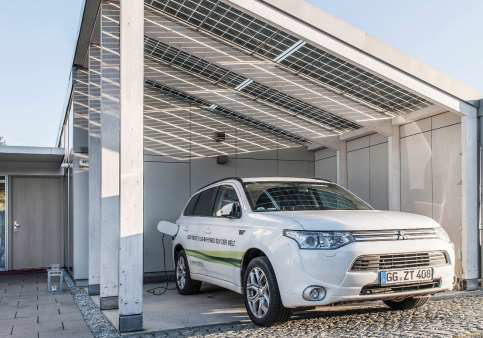
LichtAktiv Haus transformed a box-like, closed structure into an open group of spacious rooms flooded with natural light. The old building now has two children’s rooms, two bathrooms, a master bedroom, a central living area and a reading room. All rooms feature façade and roof windows that are positioned to ensure optimum distribution of natural light – and the home’s window area was increased from 18 m² to 60 m². The living area also now has a five-metre-long glass wall that opens out to the home’s garden. A new extension contains an open living and dining room, a kitchen and a utility room. A porch connects this new section of LichtAktiv Haus with the old home and also serves as the main entrance. In order to cover all the energy demands of the house withclean, renewable energy, the extension’s roof is packed with solar collectors for hot water, and photovoltaic solar cells for electricity. The concept of LichtAktiv Haus was based on the “settler spirit”, but instead of self-sufficiency in terms of food, the home is self-sufficient in terms of energy. The LichtAktiv Haus can be realised in different variants. A basic modernisation and in modules, where elements from the full proposal are used, according to financial ability, energetic ambition and need for extension square metres. The work on the final design of the modular system is still in progress.

